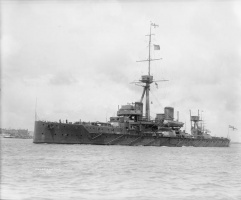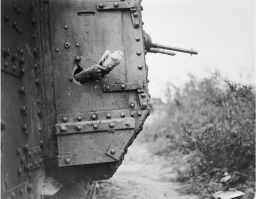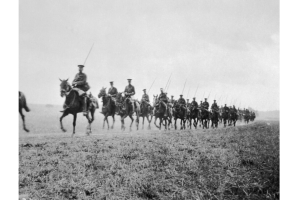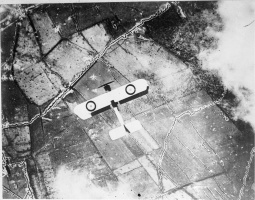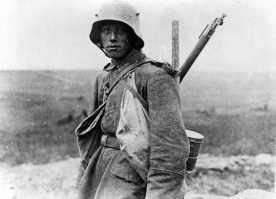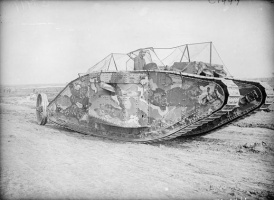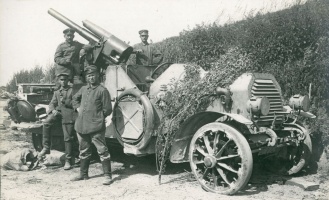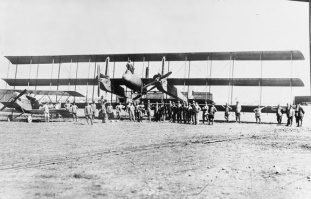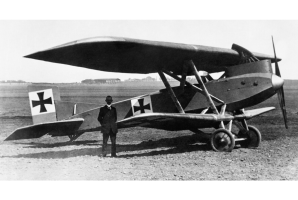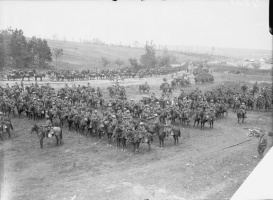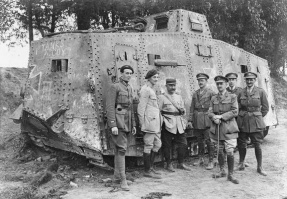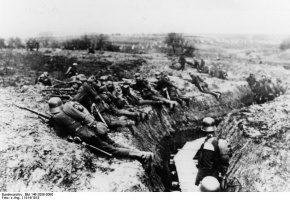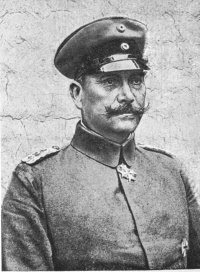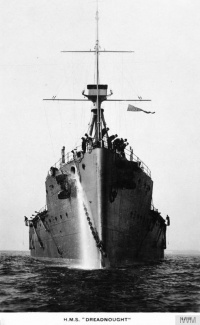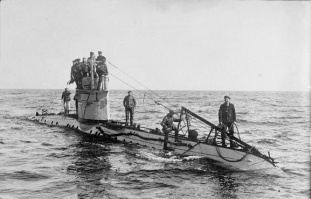Introduction↑
“Why bother studying World War I? What’s the point?” This seemingly reasonable question is asked frequently by contemporary students and quite often by seasoned scholars. After all, much of the historiography of the last hundred years has given World War I a very bad reputation. Both the popular and the scholarly images of that war paint the picture of a four-year long blood bath - a senseless war of attrition conducted by incompetent generals, without a trace of strategic thought or tactical innovation. Thus, it has become accepted wisdom that World War I has nothing to teach the student of modern war, especially in comparison to World War II, with its fast-moving armored and airborne divisions that are the basic models of military forces today.
The reality is something quite different. The scholarship over the last thirty years has shown that the period from 1914 through 1918 introduced the biggest changes in warfighting tactics and technologies in all human history. With a few significant exceptions, almost everything about how large-scale combat operations are conducted today traces its origins to World War I. If an infantry battalion commander of August 1914 were to jump ahead a scant four years to August 1918, he would be totally bewildered by what he saw happening on the battlefield around him. Almost nothing that he knew in 1914 about how to fight a battle would be of much use in 1918. On the other hand, if a battalion commander from 1918 were to jump forward to a World War II battlefield of 1940 or 1941, he would be able to understand the broad outlines of what was happening. To be sure, some military technologies would have advanced considerably in the more than twenty years, but they nonetheless would be recognizable. The battlefield problems prior to 1914 bore very little relation to those of 1918. Those of World War II were essentially the same as those of 1918 - and those of 2014 remain quite similar.
With so much change in so short a time, it was exceptionally difficult for even the most talented and intelligent of the Great War's military commanders to come to grips with the changes that seemed to come at “future shock” speed. By 1918, however, the tactical and technical solutions to the problems of the modern battlefield were starting to emerge. World War I ended in exhaustion before the new concepts could be developed fully, but the firm foundations were there for the mobile tactics and operations of World War II, and ever since.
The Three Great Paradigm Shifts in Warfighting, 1914-1918↑
A paradigm shift is a change in basic assumptions, a transformation from one framework of thinking to another. Quite often it is a revolution, a transformation, a complete metamorphosis. A paradigm shift does not just happen by itself: rather, it is driven by agents of change. The introduction of gunpowder about the 15th century was the cause of one such paradigm shift that completely altered the way wars were fought. Paradigm shifts tend to be far and few between. During the period 1914 to 1918, however, three separate but related warfighting paradigm shifts came to a head almost simultaneously, rendering most pre-1914 standard military wisdom completely obsolete, almost overnight. Nor did the new realities automatically point the way to new tactics, techniques, and procedures. They had to be developed slowly and painfully, by trial and error, costing in the process the lives of hundreds of thousands of troops on all sides. Such was the daunting challenge faced by the World War I battlefield commanders at all levels.
The first of these paradigm shifts was the transition from human and animal muscle power to machine power as the primary motive force in war. The horse had dominated the battlefield for thousands of years, providing speed and mobility to the cavalry and draft power for transport and logistics. And although horses played a major role throughout World War I, their days were clearly numbered by 1918. The transition to mechanical motive power did not occur all at once, of course, but it reached full maturity during World War I. The transition started with the invention of the steam engine and railroads during the 19th century, but it went into high gear with the development of the internal combustion engine at the end of the century. By 1918 the military technologies based on the internal combustion engine were starting to mature with the introduction of the tank and heavier-than-air combat aircraft.[1]
The aircraft ushered in the second major paradigm shift, the transition from two-dimensional to three-dimensional warfare. Up to that point battles had been fought on two-dimensional planes, although any piece of high ground on that plane gave an advantage to the side holding it. Now, aircraft made the sky itself the new high ground, and it was no longer sufficient to dominate the horizontal space within the range of your weapons. You also had to control the sky above you, or you would be vulnerable to deadly attack from the air. The problem of control of the air also extended to the battle at sea, but there the introduction of the submarine extended the battle space below the surface as well as above it. The combination of submarines and naval aircraft quickly made the heavy-gun ship-of-the-line — the battleship — obsolete.[2]
The third paradigm shift was the introduction of depth. Throughout history most battles were fought and decided at the line of contact. Now, with the advent of aircraft, long-range artillery, fire-control technologies to engage accurately targets far beyond the line of sight of the gun crews, and target-acquisition technologies capable of accurately locating deep targets, it became possible to attack an enemy force deep in its vulnerable rear areas, rather than just along the hardened defenses of its front line. Now, the combat problem became one of striking at the enemy simultaneously along his front and deep in his rear, while defending simultaneously along your own front and the vulnerable and critical installations in your own rear.[3]
Thus, warfare between 1914 and 1918 became an extremely complicated business. Never before had so many variables, so many “moving parts” been in play at the same time. And they all had to be coordinated and synchronized. Modern communication technologies played a major role in making all that possible, but rapid communications and mobility also speeded-up the process, cutting down the reaction times and the time available for the decision cycles. If warfare before 1914 was like a standard chess game, warfare since World War I has been like a multi-level chess game where each player moves ten, fifteen, or even twenty pieces at the same time.
The Tactical Level of War↑
Military Technology↑
World War I was history's first high-tech war. As James Corum noted, it “[...] constituted the most rapid period of technological change in history.” [4] Two major technological waves between 1830 and 1910 altered forever the framework battlefield tactics. The first wave ushered in breech-loading, rifled weapons of increased firing speed and accuracy. The second wave brought smokeless powder, repeating rifles, machine guns, rapid-firing artillery, and the internal combustion engine. All of these changes came together during World War I to create a technological perfect storm. The new technologies, which dramatically increased the tempo and lethality of combat operations, also made coordination between the various arms (infantry, cavalry, artillery, etc.) necessary for success on the battlefield.
All sides in 1914 had difficulties coping with and integrating the new technologies, but especially the Germans. Despite their impressive tactical and organizational innovations later during World War I, the German army remained handicapped by an institutional bias against many of the technical possibilities, and pursued instead largely tactical solutions to most of the problems of the modern battlefield.[5] As Holger Herwig noted: “In short, the Germans ignored technical innovation and mass production in favor of the hallowed concept of ‘bravery in battle.’ In the process, they denied themselves mobility and flexibility at the operational level.”[6] Hence, the infamous German failure to grasp the potential of the tank.
Writing immediately after the war, even a talented tactician like Lieutenant General William Balck (1858-1924) still defended the old dogmas when he noted: “Nothing could be worse than to place our reliance principally on technical means. The moral forces in the breast of the commander and in the soul of the entire people are the qualities which have finally turned the scales in war.”[7]
Nonetheless, other German analysts correctly identified the problem. The report of one of the post-war study commissions established by General Hans von Seeckt (1866-1936) criticized the German General Staff for having too many tacticians but not enough technicians. The Germans sorely lacked weapons specialists who really understood both the tactical effects and the limitations of current technology.[8] The Seeckt Reforms of the 1920s tackled those problems head-on, and the Reichswehr and later the Wehrmacht of World War II embraced military technology with a passion - especially the tank.
The Germans, of course, were not completely hostile to the new military technologies. In some areas, they were significantly ahead of the Allies. Most of those areas fell into the realm of firepower—field artillery, heavy artillery, mortars, machine guns. The mobility area was where they seem to have had the greatest shortcomings, which is somewhat ironic considering their exploitation of the railroad during the later 19th century.
During the years between the two world wars the various armies of the world adopted modern technologies at varying rates. The British army became history’s first completely motorized/mechanized army in 1939. The U.S. army was still using horses in 1941, but by the end of the war it was based completely on the internal combustion engine. Despite their embrace of the tank, the German army overall was still heavily dependent on horses right through 1945, as was the Soviet army.
Fire and Maneuver↑
The two basic elements of combat power are firepower and maneuver. Firepower produces the kinetic energy effect that destroys, neutralizes, or suppresses an objective. Maneuver is movement throughout the battle space to gain positional advantage. The two complement each other. The side with greater positional advantage can position its firepower to better effect; and the side with superior firepower can better support its maneuver element. Over the course of military history, these two elements have been locked in a cyclical struggle for dominance. Rarely has one gained dominance over the other, or held it for very long. But in the seventy or so years before the start of World War I, firepower technology had advanced much farther and faster than mobility technology. Bolt-action rifles, machine guns, and rapid-firing artillery had increased drastically the rates of fire, but battlefield mobility still plodded along at the speed of a man or a horse. That would begin to change by 1918, with the emergence of combat aircraft, the tank, and the increased use of motor vehicles. By 1939, the balance between fire and maneuver was almost restored, which largely explains why World War II did not bog down in trench warfare. But, for most of World War I, maneuver in the face of such overwhelming firepower became almost suicidal. The result was trench warfare. [9]
Trench Warfare↑
At the start of the war, most of the world’s armies had tactical doctrines based on combat operations consisting of vast sweeping maneuvers and meeting engagements. Neither side anticipated or planned for anything like the long and drawn-out static warfare that actually developed, but many military thinkers did recognize the basic problems of modern warfare. In his five-volume book published in 1899, the Polish civilian banker Jan Bloch (1836-1902) argued that modern weaponry made offensive maneuver all but impossible.[10] Some military theorists agreed with Bloch that the new technologies reinforced the inherent superiority of the defense; others, however, believed the powerful new weapons gave the advantage to the offense. There was no common consensus for a solution to the problem of fire and maneuver. Many planners, likewise, recognized that any war on the Continent would be a long one, rather than the short and decisive war everyone hoped for.[11]
The large numbers of troops committed at the start of the war quickly created a massive force density along the German, French, and Belgian borders, leaving little room for maneuver and no open flanks to exploit. That problem was compounded by the firepower-maneuver disconnect. The Wars of German Unification ended in 1871, and from then until 1914 there had been no major wars in western or central Europe. During that same period, the vast technological improvements in weapons resulted in greatly increased range, accuracy, volume of fire, and lethality that placed the soldier in the open at a distinct disadvantage to the soldier fighting from a protected position.
During the early battles of August and September 1914, there was a great deal of attempted maneuver. But, as both sides groped across the battlefield searching open flanks that did not exist, firepower took its grim toll. The troops themselves soon realized the near impossibility of survival on the surface of the earth. Soldiers on all sides hated (and still hate) the spade, but the overwhelming volumes firepower forced them to dig.[12] By the end of 1914, the Western Front had stabilized into two roughly parallel lines of foxholes and hasty trenches running from the Swiss border to the North Sea. As the war continued, these defenses became more elaborate and semi-permanent. The Eastern Front never quite solidified into the static and rigid network of trenches and fortifications so typical of the Western Front. While the problem on the Western Front was too many forces in too little space, the problem on the Eastern Front was just the opposite. The flat terrain and open spaces in the east, combined with the increased firepower yet very limited mobility of the World War I armies, resulted in the Eastern Front's own brand of stagnation.
Many professional soldiers clung to the belief that aggressive spirit was the only way the attacker could overcome modern firepower. In the French army, especially, the doctrine of attaque à l’outrance was advocated primarily by Colonel Loyzeaux de Grandmaison (1861-1915) and Brigadier General Ferdinand Foch (1851-1929). As Lieutenant Colonel Pascal Lucas noted writing after the war, “Our officers had absorbed the theory of the offensive to the point where it had become a disease.”[13] The relatively few advocates of firepower, like Colonel Philippe Pétain (1856-1951), were largely ignored. The cult of the offensive became a substitute for any coherent system of tactical doctrine.[14]
On all sides, commanders came to regard the static lines of fixed fortifications of trench warfare as an unnatural and temporary situation that had to be overcome in order to return to the “natural” condition of maneuver warfare. The military tacticians of the period, therefore, concentrated on ways to restore the old paradigm, failing to understand that the central paradigm of war itself had shifted. War was no longer a contest between two opposing forces of blood, muscle, and bayonets, but now a struggle between two armies consisting of machines. The most important human roles in warfare were now the operation and direction of those machines. Military commanders on all sides, then, spent much of the first three years of World War I trying to prevail with manpower in history’s first mechanized war.[15] The new weapons and technologies also made coordination among the various arms absolutely essential. Gone forever were the days when massed infantry alone, attacking with bayonets could win battles. By the end of World War I, the foundations of combined arms warfare were firmly in place, with infantry, artillery, armored fighting vehicles, and aircraft covering each other’s weaknesses and reinforcing each other’s strengths.
The greatly improved range, accuracy, and rates of fire of artillery created serious challenges for coordinating its fires with the infantry on the battlefield. Indirect fire techniques, which allowed guns to engage targets far beyond the line of sight of their crews, combined with the still primitive communications systems, made close support of the infantry very difficult the farther the attack advanced from the line of departure. Radio was still in its infancy. The telephone worked well enough in defensive situations, but during an attack, messengers were the only way to send and receive requests for fire support and corrections. That sometimes took hours, assuming the messengers survived to get through. One solution to the problem was to advance the artillery fire on a pre-set schedule, controlled by phase lines on the map. That technique evolved into the creeping barrage, with the attacking infantry trained to follow closely behind the moving wall of their own artillery fire. Infantry commanders were ordered to keep their lead troops as close as possible to the advancing barrage, even though they almost certainly sustained casualties from friendly fire in the process. The underlying assumption was that the closer the infantry hugged to the back of the barrage, the less time the defending enemy would have to recover and react when the leading attack wave reached the objective.
Creeping barrages, phase lines, and rigid firing schedules, however, completely subordinated the infantry advance to the artillery plan.[16] The result was rigid linear infantry advances, with tactical decisions centralized at higher and higher levels. But, the communications systems of the period were inadequate for greater centralization of control, resulting in slower response times. Thus, front line infantry commanders had no alternative but to ignore terrain in their planning, and they had less and less control of their immediate tactical situations. By the middle of the war, the basic principles of battlefield maneuver had largely been forgotten. Attack planning was reduced to fixed sets of mathematical formulae, a function of the numbers of heavy guns, machine guns, and riflemen per hundred meters of front in the primary attack sector, and the number of rounds to be fired during the artillery preparation. If the attacking commander was willing to pay the price in casualties and ammunition, the enemy’s forward positions could always be taken, and usually his second line as well. Penetrating deeper into the enemy’s positions was the real problem. By that stage of the attack, the leading infantry elements were totally spent and they did not have the mechanical means of mobility to continue the advance. The supporting artillery too was most likely firing at the maximum limit of its range, and did not have the mechanical means to displace forward.
For the attack to continue, therefore, fresh infantry units had to be moved up and the artillery somehow had to be brought forward over the shattered and broken ground, littered with the refuse of war. The only way for the infantry to move was by foot, and the artillery could only move with horses, which could only be worked so hard and were extremely vulnerable to enemy fire. While that was going on, the defender, who was operating within his own lines, was able to reinforce the threatened area much more quickly by taking advantage of the roads and rail networks in his own rear area. The essence of the problem, then, was that the attacker’s poor tactical mobility could not overcome the defender’s greater strategic mobility.
Infiltration Tactics↑
By mid-1917, many Allied commanders had realized that decisive penetration was no longer possible. Pétain, among others, advocated limited objective attacks, designed to reduce systematically an enemy’s position in small portions.[17] Some tacticians, however, were thinking along bolder lines. In May 1915, French Captain André Laffargue (1891-1994) argued in a pamphlet that specially trained teams of skirmishers armed with light machine guns and grenades should precede the main attack. The mission of these special groups was to infiltrate into the German lines ahead of the main attack, locate and neutralize the deadly German machine guns, and even probe deeply enough to disrupt the German artillery. Laffargue's pamphlet at first did not get much serious attention from the British and French armies. The Germans, however, translated and printed a captured copy during the summer of 1916.[18]
Captain Wilhelm Rohr (1877-1930) was one of the major German pioneers in the development of new offensive tactics. In August 1915 on the Western Front Rohr was assigned command of the recently formed Assault Detachment (Sturmabteilung). Under Rohr’s training and leadership, the Assault Detachment developed and executed very successful counterattack tactics based on the traditional non-linear tactics of the earlier German Jäger units. The basic tactical element was the assault squad (Stoßtrupp), armed with grenades, automatic weapons, trench mortars, and flamethrowers. Rohr’s tactics and techniques were very similar to those advanced by Laffarague.[19]
By the end of 1917, each German field army had an assault battalion that functioned as a training cadre.[20] These special assault units became known as Storm Troops (Stoßtruppen). The storm battalions were one of the earliest forms of a true combined arms task force. Typically, their structure included three to four infantry companies; a trench mortar company; an accompanying artillery battery; a flamethrower section; a signal section; and a pioneer (combat engineer) section.[21] In March 1917, the German army also restructured their standard German infantry squads based on a seven-man team as a maneuver element, and a fire element based on a four-man team armed with the M-1908/15 light machine gun.[22] The German Wehrmacht of World War II retained that basic infantry squad structure.
Rohr's infiltration tactics, developed largely in a counterattack role, were eventually adopted as official German attack doctrine on the Western Front. In September 1917, the Germans successfully used the new tactics for the first time on a large scale at the Battle of Riga, on the Eastern Front. Instead of the typical attack formations of rigid lines advancing at a fixed pace, the German Eighth Army of General Oskar von Hutier (1857-1934) attacked in fluid leaps and bounds. One element moved forward while a supporting element provided fire cover. Then the two elements reversed roles and leapfrogged each other. The leading elements completely bypassed and isolated the defender’s forward strong points, which were later eliminated by heavier follow-on forces. Rather that being thrown in where an attack was faltering, reserves were committed only to reinforce and exploit success.
The Germans used similar tactics during their successful attack at Caporetto the following month. The results of those two battles shocked the Western Allies, although for some time they failed to grasp the underlying tactical principles. The Germans used storm-troop tactics on a large scale for the first time on the Western Front during their counterattack at Cambrai on 30 November 1917. On 1 January 1918, the German High Command (Oberste Heeresleitung) formally issued the new offensive doctrine, The Attack in Position Warfare (Der Angriff im Stellungskrieg).[23]
The new doctrine organized the attack into two principal phases. The initial methodical assault against the enemy’s organized positions was based on detailed preparation and centralized control. It was followed by an aggressive exploitation of the attack characterized by decentralized execution and initiative on the part of the subordinate commanders. The purpose of the second phase was to disrupt the defender’s ability to reorganize and respond. This phase began in the intermediate zone, beyond the range of the creeping barrage, substituting shock and audacity for fire support.[24]
Depth and speed contributed to the flank security of the leading elements, whose immediate objective was to penetrate as deeply as possible into the defender’s positions, at a minimum reaching and overrunning the enemy’s artillery positions on the first day. The new doctrine was based on infantry-artillery coordination, with artillery neutralization fire emphasized over destruction. The intent was to disrupt the enemy's communications, and bypass and isolate his strong points. The new tactics represented key conceptual shift from destruction to large-scale disruption.[25]
Artillery and Neutralization Fire versus Destruction↑
Because firepower mechanization was so much more advanced than mobility mechanization, artillery dominated World War I as no other war in history. Artillery turned into a blunt instrument for hammering large sections of ground. The main functions of artillery on the battlefield became destruction and annihilation—destroy the attacking enemy forces before they reached friendly lines; and destroy the defending enemy before attacking friendly troops reached the hostile positions. Artillery was expected to obliterate the enemy's fortifications and trench works, and even cut holes through the barbed wire in front. The prevailing tactical philosophy of the war became, according to a quote attributed to Petain, “The artillery conquers, the infantry occupies.”
Throughout the war, leaders on both sides and at all levels searched for ways to break the deadlock. The Germans on the Eastern Front especially, experimented aggressively with artillery tactics. The key to the new fire support thinking that started to emerge during 1916 was the idea that artillery fire was more effective when its tactical effect was neutralization rather than destruction. While neutralization was a temporary effect, it only had to last long enough for the attacking infantry to take the objective. Thus, the evolving artillery neutralization tactics complemented the emerging infantry infiltration tactics.
The most influential artillery tactician of the war was Colonel Georg Bruchmüller (1863-1948), a previously obscure, medically retired German officer recalled to active duty in 1914.[26] Starting on the Eastern Front as early as 1915 and culminating in the 1917 battle of Riga, Bruchmüller experimented with and developed fire support methods that were radical departures from convention. Bruchmüller was one of the earliest advocates of neutralization. He understood the counter-productive nature of the long, destruction-oriented artillery preparations that actually made the attack more difficult and telegraphed the attacker’s intent. Thus, while the artillery preparations prior to attacks in the West were lasting weeks, Bruchmüller planned and executed preparations in the East lasting only a few hours, yet achieving better effect. Although preparations were not long, they were incredibly violent—designed not to obliterate a defending enemy, but to stun him senseless. In Bruchmüller’s own words, “We desired only to break the morale of the enemy, pin him to his position, and then overcome him with an overwhelming assault.”[27]
Bruchmüller was one of the first to organize artillery preparations into distinct phases, with each phase intended to accomplish a specific tactical purpose. The typical Bruchmüller preparation had three main types of phases: A short surprise strike on command and control and communications targets; A period of reinforced fire against the enemy artillery; and attack in depth of the defender's infantry positions. Bruchmüller concluded the last phase with a short sub-phase of saturation fire against the leading enemy infantry positions.[28] Both the U.S. and Soviet/Russian Armies to this day use variations of the basic Bruchmüller preparation model.
At the battle of Lake Narotch in April 1916, Bruchmüller became the first artillery commander in the German army to plan and coordinate fires above the divisional level.[29] One of his greatest innovations was a system of task-tailored artillery groups, each with a specific mission to perform during the battle. Ignoring the organizational differences between German field artillery and foot artillery (heavy artillery), Bruchmüller assembled his groupings with combinations of both types of units and guns, based on the requirements of the specific mission. He managed to do this in the face of significant opposition from many of the hide-bound traditionalists in the German army. The main mission of the counter-artillery groups (Artilleriebekämpfungsartillerie, or AKA) was to neutralize the enemy's artillery. The counter-infantry groups (Infantriebekämpfungsartillerie, or IKA) struck at the enemy infantry positions. During the reinforced counter-battery phase of the preparation, however, the IKA guns joined in with the AKA guns to overwhelm the enemy batteries.
Bruchmüller was also an early proponent of centralized fire planning and command and control. The IKA units were controlled by the divisions, the AKA units were controlled by corps. At the field army level, Bruchmüller established special heavy artillery groups (Schwerste Flachfeuerartillerie, or SCHWEFLA). These units fired highly selective destruction missions against critical high-value targets, including rail centers, bridges, and concrete-reinforced command posts. At the corps level, Bruchmüller also established long-range artillery groups (Fernkämpfartillerie, or FEKA), whose mission was interdiction against reserves and other deep targets. Bruchmüller's FEKA groups were among the first units to appear on the modern battlefield with a specific deep-battle mission, and were the first tube artillery units to deliver operational fires.
Accuracy in artillery fire was, and still is, the principal technical challenge. The primary way to achieve accuracy was to fire a registration against a target having a precisely known location. By comparing the “should-hit” firing data to the “did-hit” data a set of corrections was derived and applied against future targets. The system worked something like zeroing a rifle. The only problem was that in registering, an artillery battery gave away its position, and it usually became an instant enemy counter-battery target in the process. Also, hundreds of batteries suddenly registering in a given sector were a clear indicator that a major attack was in the works.
While still on the Eastern Front Bruchmüller experimented with various methods to eliminate or abbreviate the registration, and thereby avoid telegraphing the attack. After Bruchmüller was transferred to Western Front in late 1917, he learned about and quickly became the principal advocate of a newly developed mathematical technique to “predict” registration corrections from careful measurement of weather conditions and muzzle velocity characteristics of each gun tube. The system, developed by Captain Erich Pulkowski (1877-19??), required precise calibration data from each gun tube to determine its velocity error, which the Germans called “special influences.” The gun, however, did not need to be fired in the line to obtain such data. It could be done in a rear area, where the calibration firing could not be observed by the enemy. The special influences were then algebraically combined with the weather, or “daily influences.” The Germans used a limited version of the “Pulkowski Method” during Operation MICHAEL, the first of the great Ludendorff Offensives in March 1918. They used the full version of the system in the remaining four of the 1918 offensives. The result was stunning tactical surprise.[30] The basic mechanics of the Pulkowski Method are still used by all NATO armies today as the MET+VE procedure, albeit computerized.
Bruchmüller was not the only artillery innovator of the war, of course; nor did he personally develop all of the techniques he used so effectively. He did, however, perfect many of them on the battlefield, and he was the first to integrate them all into a comprehensive and devastatingly effective system. French artillerymen, for the most part, were always several steps behind the Germans. They were slow to accept a return to neutralization, and to understand the value of surprise. Several British Gunners, on the other hand, had been advocating many of the same principles as the war progressed. Foremost among that group were Lieutenant-General Sir Noel Birch (1865-1939), Major-General Sir Herbert Uniacke (1866-1934) - known in Royal Artillery circles as “the British Bruchmüller” - and Brigadier-General Henry H. Tudor (1871-1966). For the most part, they were held back by Field Marshal Sir Douglas Haig's (1861-1928) prejudices on artillery, and the more rigid British staff system. The British attack at Cambrai actually pre-dated the Germans in the use of a system to predict artillery corrections without registering. Technical errors in the application, however, produced mixed results.
Tanks↑
The tank was either the most potentially decisive weapon of World War I, or the most overrated. Almost one hundred years after the end of the war the debate continues. What is clear is that the Germans were far slower than the Allies to recognize the potential of the new weapon system, and a number of factors contributed to this. Even before the start of the war, the Germans had conducted trials with armored cars armed with light guns and machine guns. General Friedrich von Bernhardi (1849-1930) dismissed the whole thing, writing, “[...] no serious military value can really be attached to these experiments.”[31] The British used tanks for the first time on the Somme on 15 September 1916. Committed in small numbers, they produced some initial surprise effect, which did not last long. The French first used them on 16 April 1917, but the results were bad because of poor terrain.
The initial poor results led General Erich Ludendorff (1865-1937) and many others at German Army Supreme Command (Oberste Heeresleitung, or OHL) to conclude that the tank was little more than a nuisance weapon that could be neutralized with the right tactics. The German solution included special training for artillery crews, the construction of anti-tank obstacles, and the introduction of a 13 mm anti-tank rifle that required a crew of two to operate it. The first German tactical manual on tank operations, issued in January 1918, classified the tank as an auxiliary weapon that could not be decisive on its own. Its primary mission, rather, was to support the infantry in reaching its objectives. Ludendorff thought that the primary functions of the tank were crushing enemy barbed wire and overrunning machine gun positions.
Some of the General Staff officers at OHL, however, began to see the tank differently after the British committed them in mass for the first time at Cambrai on 20 November 1917. After the Allies’ 18 July 1918 counterattack at the Marne, which was spearheaded by 759 tanks, OHL General Staff officer Colonel Albrecht von Thaer (1868-1957) noted in his diary that, “even Ludendorff” should now recognize the power of the tank.[32] Nonetheless, Ludendorff in his post-war memoirs continued to insist; “The best arms against tanks are the nerves, discipline, and intrepidity. Only with the decline in discipline and the weakening of the fighting power of our infantry did the tanks in their mass employment and in conjunction with smoke gain a dangerous influence on the course of military events.”[33] The Germans finally produced their own massively large A7V tank, but they only fielded fifteen of them and used another seventy-five captured Allied tanks. By the end of the war, the British had built 2,636 tanks and the French had built 3,900. Thousands more were on order for the Allies’ anticipated 1919 campaign.[34]
The question remains - just how effective was the tank in World War I? Major-General J.F.C. Fuller (1878-1966) argued that the Germans would have won the war in early 1918 if they had concentrated all their manufacturing resources on field guns and tanks.[35] Even General Hermann von Kuhl (1856-1958) wrote that the March 1918 Operation MICHAEL offensive would have succeeded, “[...] if 600 tanks had cleared the way for our infantry.”[36] But Major-General Hubert Essame (1896-1976) later posed the question that if tanks alone had been the panacea for victory in 1918, how then did the Germans manage to penetrate so much deeper during their Spring 1918 Offensives without tanks than the Allies did later with them?[37] John Terraine (1921-2003) pointed out that the number of tanks the Allies managed to mass for the first day of any given attack did not matter, regardless of how spectacular the results that day might seem. The important fact was how many operational tanks they had in action on the second and subsequent days of the attack. Tanks in 1918 were mechanically very unreliable. And, as the German experience against tanks increased, their anti-tank methods became more sophisticated and effective.
During the 18 July 1918 counterattack at the Marne by General Charles Mangin’s (1866-1925) French Tenth Army, 346 tanks were available; only 225 actually made it across the line of departure; and 102 were knocked out. On the following day, 195 were operational, and fifty of those were knocked out that day. By the third day, the French had only thirty-two operational tanks. During the British counterattack at Amiens on 8 August 1918, Ludendorff's “Black Day of the German Army,” 414 tanks were available for action on the first day; 145 on the second day; eighty-five on the third day; thirty-eight on the fourth day; and by 12 August the British had only six operational tanks.[38]
The potential of the tank in World War I may be overrated, but its impact on the conduct of land warfare after 1918 cannot be disputed. Britain, France, America, Germany, and the Soviet Union all developed tanks during the interwar years. But no matter how sophisticated and advanced a military technology may be, its effectiveness in actual war is a function of the tactics with which the hardware is employed. During the Battle of France in May and June 1940, the French and the British combined actually had more tanks than the Germans, and the Allied tanks were generally better; but the Allies dispersed their tanks across their line, in “penny packets.” The Germans concentrated their tanks into powerful Panzer divisions, which they then directed against decisive objectives. In hindsight, the lesson of concentration was clearly there to read from the September 1915 experience on the Somme.
Air Power↑
Perhaps no other weapon system ever went through a steeper growth curve than the aircraft in World War I. At the start of the war, airplanes were used for reconnaissance only. By the end of the war, all sides had purpose-built aircraft for reconnaissance, bombing, and air superiority roles. In 1917, the Germans introduced the Junkers J-1, armed with three machine guns and a bomb load. It was both the world's first all-metal aircraft, and the first one specifically designed for ground attack and infantry close support.[39]
In September 1915, aircraft losses on both sides of the Western Front totaled thirty-seven. By August 1918, the combined total was 832. Throughout the war, the Germans produced some 47,637 aircraft of 150 different types. The Allies produced 138,685.[40] At any given time, the Allies outnumbered the Germans 2:1 in the air. The Germans countered Allied numerical superiority by forming larger units and concentrating their forces in the sectors where they needed local air superiority to support ground operations. The Germans consistently shot down between two and three Allied aircraft for each of their own losses. Training deaths accounted for 25 percent of the total German pilot losses, while in the Royal Flying Corps the figure was closer to 50 percent.[41]
The aircraft of 1918 were still very primitive compared to the aircraft of World War II, and especially today. But most of the military functions of modern aircraft were in place by the end of World War I. The two exceptions were cargo aircraft and the helicopter. Between the world wars, transport, or cargo aircraft developed, and as their range and carrying capacity increased, the military airlift function expanded accordingly. Transport aircraft also made airborne, or parachute troops possible. Introduced in the closing days of World War II, the helicopter initially was used for observation and transporting light loads into forward areas with no airstrips. By the Vietnam War, armed helicopter gunships took on much of the ground support function, and larger transport helicopters were capable of carrying troops directly into battle, replacing much of the function of parachute troops.
Between the world wars, different countries pursued alternate paths in the development of military aviation. Britain and the United States especially, followed the theories of World War I Italian General Giulio Douhet (1869-1930) in developing large aerial fleets of strategic bombers.[42] Germany, on the other hand, developed the Luftwaffe based on air superiority fighters, ground attack dive bombers, and shorter range medium bombers. When World War II started, neither side had a properly balanced air force, but American industrial superiority enabled the Allies to correct the deficiencies during the course of the war.
Command, Control, and Communications↑
Communications provide the vital link that ties together fire and maneuver and makes possible the coordination and synchronization of many elements over a wide area. Effective, secure, and rapid communications are an essential prerequisite for the successful prosecution of modern war.
The real-time and near-real-time communications systems modern soldiers take for granted did not exist during World War I. Morse code and telephone voice communications by wire were fairly well developed, but radio was in its infancy. All armies made extensive use of non-electronic communications systems that had been in use for hundreds, if not thousands of years. The faster electronic systems were more effective in the defense, the older and slower manual systems were more effective in the offense. This, especially, made responsive fire support difficult, as artillery observers moved forward with the advancing infantry and had no rapid means to coordinate with their batteries.
The more primitive communications techniques were much slower, but also tended to be more reliable under combat conditions. Messengers, both foot and mounted, had the highest casualty rates of any job in the war. But, when multiple messengers were sent out with the same message, the system was generally reliable under fire. Both sides also made wide use of carrier pigeons and messenger dogs. The dogs were very reliable within a two-kilometer radius. The pigeons were relatively uninfluenced by fire and gas, but they required clear weather and were only effective for front-to-rear communications.
All sides tried various ways to exercise effective command and control over a wide area with the primitive and slow communications technology of the day. The Allies generally tried to centralize both planning and execution at the highest levels, which in the end robbed subordinate commanders of all initiative and made it almost impossible to exploit rapidly tactical opportunities as they arose.[43] The Germans, on the other hand, retained a fairly high level of centralized planning, but pushed the execution down the chain of command as far as possible. The Germans also permitted their junior leaders on the spot far greater latitude in determining how to execute orders. That system developed into what today is called Auftragstaktik, generally defined in English as mission-oriented tactics. During World War II, the Wehrmacht developed Auftragstaktik to a high art. Ever since World War II the U.S. army has done much talking about Auftragstaktik, but still has great difficulty in making it work.[44]
Advances in communications technologies continued at a rapid pace between the two world wars. In ground operations, radio made it possible for commanders to synchronize and control units spread over vast distances. It also reduced most of the reaction times necessary for artillery support, and gave fire direction officers the ability to mass fire from many widely spread batteries onto a single target, with devastating effect. In the air, radio communications made it possible for aircraft in flight to coordinate their actions, and to coordinate close support for troops on the ground. Radar was one of the very few electronic technologies of World War II that did not have its origins in World War I.
War at Sea↑
World War I changed naval warfare forever. The great irony of World War I was that no truly decisive naval battle ever took place, although sea power, in the form of the naval blockade of Germany, was one of the decisive factors in the war’s outcome. The indecisive Battle of Jutland in 1916 was history’s first, and last, major clash between two modern battleship fleets. When the HMS Dreadnought was launched in 1906, it instantly made every other battleship in the world obsolete. Yet, by 1918, Dreadnought-type battleships themselves were well on the way to becoming obsolete.
Most of the world’s major navies entered World War I regarding the submarine as an auxiliary craft, a nuisance weapon at best. The Germans, however, turned to U-boats in a major way after they decided it was more important to maintain their surface High Seas Fleet as a “fleet in being,” rather than risking it in a decisive engagement. When U-boats started attacking Allied shipping in the Atlantic and Mediterranean, the Allies began to develop countermeasures resulting in the doctrines of modern submarine warfare and anti-submarine warfare. Convoying emerged as the principal defensive technique, which would prove its worth to an even greater degree during World War II. Early research efforts into sonar (which the British called ASDIC) did not result in a deployable system by 1918, but it did shortly thereafter. Average U-boat life expectancy was only six war patrols. During the war, the Germans built 344 U-boats, but by mid-1917, they had lost 150.[45] As early as 20 June 1917 Admiral Sir John Jellicoe (1859-1935), the First Sea Lord, shocked a meeting of the British War Cabinet by telling them that owing to the great shortage of shipping due to German submarines, it would be impossible for Britain to continue the war in 1918. "There is no good in discussing plans for next spring," he said, "we cannot go on."[46] Although the War Cabinet refused to accept Jellico’s bleak assessment, British maritime commerce was nonetheless under severe pressure.
Naval aviation started with battleships and cruisers carrying individual floatplanes for scouting purposes. Launched from shipboard catapults, the aircraft mounted pontoons rather than standard wheeled landing gear. After returning from a patrol the aircraft could land in the water near the ship, to be recovered by a shipboard crane and placed back on the catapult for re-launch. On 4 May 1912, the first plane to take off from a ship underway flew from the deck of the pre-dreadnaught battleship HMS Hibernia. Before World War I ended, the first flat-deck aircraft carrier entered service. HMS Argus in 1918 was the first warship capable of launching and landing naval aircraft. By the start of World War II, the aircraft carrier was the world’s premier strategic power projection platform. All world-class naval fleets today are based on the submarine and the aircraft carrier.
The Operational Level of War↑
World War I marked the start of the emergence of operational art and the modern operational level of warfare, as distinct from the tactical and the strategic levels. The purpose of tactics is to win battles. The purpose of strategy is to win wars. The purpose of the operational art is to win the campaigns, which are based upon battles and which in turn contribute to strategic victory.[47] The operational level of war is the vital link between the tactical and strategic levels.
Strategy and tactics have long been identified as distinct albeit connected spheres of military theory and action. The notions of the operational art and the operational level of war are of far more recent origin. The military theories underlying the operational art did not evolve uniformly; rather, they progressed sporadically over the course of the last two centuries. In earlier times, it was often possible to win a war by winning a single decisive battle, what the Germans called the Vernichtungsschlacht (the battle of annihilation). That became less and less likely as wars became larger and more technologically complex. The experience of World War I dramatically demonstrated that single engagements no longer guaranteed the successful outcome of a campaign, and that cumulative tactical success was no guarantee of strategic success. Decision could only brought about by “successive operations linked by intent, location, allocation of resources, and concerted action.”[48] This was the clear lesson of the failed German Spring Offensives of 1918. Instead of a coherent series of operations, each designed to build upon the success of the previous one, the Germans between 21 March and 15 July 1918 launched five separate large-scale attacks, each one intended to be the decisive battle that ended the war. When one offensive failed, they tried the same sort of thing again somewhere else.[49] The Allied “Hundred Days Campaign” that followed, however, was just such a series of coordinated and synchronized blows that in the end defeated Germany militarily. Between 1914 and the middle of 1918, however, most military leaders surrounded by the fog of war repeatedly tried to plan and conduct single battles of annihilation, such as at Verdun or the Somme, that would produce decisive strategic results.[50]
During the years following World War I, Soviet military theorists especially made many significant contributions to the evolution of the operational art as we understand it today. Even prior to World War I, Russian military writers around 1907 introduced the concept of Opertika.[51] Following World War I Soviet operational thought was advanced by the theories of Marshal Mikhail N. Tukhachevsky (1893-1937) and Vladimir K. Triandafillov (1894-1931). Triandafillov was the first to introduce the planning “norms” that became one of the benchmarks of Soviet operational planning during World War II and the era of the Cold War.
The post-World War I German army also contributed significantly to the understanding of the level of war between the tactical and the strategic. The 1933 edition of Truppenführung, the primary German warfighting manual of World War II, distinguished clearly between tactical and operational functions.[52] The doctrine in Truppenführung, also laid the foundations for the Panzer operations of World War II and the form of highly mobile warfare popularly but incorrectly called Blitzkrieg.
Although the evidence was clearly there from World War I on, most Western armies, particularly the American military and NATO, refused for many years to accept the construct of a level of war between the tactical and strategic, and a specific body of military theory called the operational art. That finally changed in the early 1980s, following the U.S. military’s complete reevaluation of its military doctrine in the wake of the Vietnam War. The concept of the operational level of war is today almost universally accepted.
Conclusion↑
As British Major General Jonathan Bailey has noted:
And further on he concludes:
It is no wonder, then, that the battlefield commanders of World War I had such great difficulty coming to terms with the changes taking place and formulating effective responses. But although all the wars that have followed World War I are more similar to it than it was to all the wars that proceeded, no two wars are ever exactly the same. Military planners cannot draw upon the same precise historical analysis that is central to, for example, the medical and legal professions. The key reason that military planners cannot forecast future contingencies in absolute terms is because it is in the very nature of war that enemies adapt against each other. Thus, soldiers must continually be prepared to deal with the unexpected and apply their training, doctrine, and equipment to the situation at hand. The real lesson of World War I, then, is that the true measure of military effectiveness is not what was successful in the past, but rather what works now.
David T. Zabecki, United States Naval Academy and University of Birmingham
Section Editors: Michael Neiberg; Sophie De Schaepdrijver
Notes
- ↑ The muscle-to-machine power paradigm shift is discussed in Travers, Tim: The Killing Ground: The British Army, The Western Front and the Emergence of Modern Warfare, 1900-1918, London 1987.
- ↑ The shift from two- to three-dimensional warfare is discussed in Bailey, Jonathan B.A.: The First World War and the Birth of the Modern Style of Warfare, The Strategic and Combat Studies Institute, Camberley 1996.
- ↑ The transition from the contact battle to the deep battle is discussed in Zabecki, David T.: The German 1918 Offensives: A Case Study in the Operational Level of War, London 2006.
- ↑ Corum, James S.: The Roots of Blitzkrieg: Hans von Seeckt and German Military Reform, Lawrence 1992, p. 18.
- ↑ Dupuy, Trevor N.: A Genius for War: The German Army and General Staff, 1807-1945, New York 1977, p. 169.
- ↑ Herwig, Holger: The Dynamics of Necessity: German Military Policy During the First World War, in: Millett, Alan R./Murray, Williamson: Military Effectiveness, Volume I: The First World War, Boston 1988, pp. 94-95.
- ↑ Balck, William: Development of Tactics—World War, Bell, Harry (trans.), Fort Leavenworth 1922, p. 129.
- ↑ Theobeck, Kurt: Erfahrungen und Lehren des Weltkriegs 1914 bis 1918 auf Waffentechnichem und Taktischem Gebit (12 April 1920), Bundesarchiv/Militärarchiv, Freiburg, Germany, File RH 12-2/94.
- ↑ Bailey, Jonathan B.A.: Field Artillery and Firepower, Annapolis 2003, pp. 123-150.
- ↑ Bloch, Jan de: The Wars of the Future, in: Bloch, Jean de: Jean de Bloch: Selected Articles, Fort Leavenworth 1993, pp. 1-40.
- ↑ Strachan, Hew: The First World War, Volume I: To Arms, New York 2001, pp. 1005-1014; Herwig, Holger: Germany and the ‘Short-War’ Illusion: Toward a New Interpretation?, in: The Journal of Military History 66/3 (2002), pp. 681-693.
- ↑ Lupfer, Timothy T.: The Dynamics of Doctrine: Changes in German Tactical Doctrine During the First World War, Leavenworth Papers 4, Fort Leavenworth, Kansas July 1981, p. 2.
- ↑ Lucas, Pascal: The Evolution of Tactical Ideas in France and Germany During the War of 1914-1918, Kieffer, P.V. (trans.), Fort Leavenworth 1925, p. 6 (French publication, Paris 1923); Griffith, Paddy: Forward into Battle: Fighting Tactics From Waterloo to the Near Future, Novato 1991, pp. 84-94.
- ↑ Holmes, Richard: The Western Front, London 1999, pp. 30-35.
- ↑ Travers, The Killing Ground 1987, pp. 48-55, 62-78.
- ↑ Lucas, The Evolution of Tactical Ideas 1925, p. 87.
- ↑ Ibid., p. 105.
- ↑ Wynne, Graeme C.: If Germany Attacks, London 1940, pp. 57-58; Lucas, The Evolution of Tactical Ideas 1925, pp. 38, 109.
- ↑ Gudmundsson, Bruce I.: Stormtroop Tactics: Innovation in the German Army, 1914-1919, Westport 1989, pp. 47-53.
- ↑ Ibid., pp. 77-79, 96; Lupfer, The Dynamics of Doctrine 1981, p. 43.
- ↑ House, Jonathan M.: Toward Combined Arms Warfare: A Survey of 20th Century Tactics, Doctrine, and Organization, Fort Leavenworth 1984, p. 35.
- ↑ Wynne, If Germany Attacks 1940, p. 295; Corum, The Roots of Blitzkrieg 1992, p. 9.
- ↑ Oberste Heeresleitung, Der Angriff im Stellungskrieg, in: Ludendorff, Erich: Urkunden der Obersten Heersleitung über ihre Tätigkeit 1916-1918, Berlin 1921, pp. 641-666.
- ↑ Lucas, The Evolution of Tactical Ideas 1925, pp. 132, 138; Balck, Development of Tactics 1922, p. 266.
- ↑ Travers, The Killing Ground 1987, p. 260; Balck, Development of Tactics 1922, p. 264.
- ↑ For a complete assessment of Bruchmüller see Zabecki, David T.: Steel Wind: Colonel Georg Bruchmüller and the Birth of Modern Artillery, Westport 1994.
- ↑ Bruchmüller, Georg: Die Deutsche Artillerie in den Durchbruchschlachten des Weltkriegs, 2nd ed., Berlin 1922, p. 80.
- ↑ Bruchmüller, Georg, Die Deutsche Artillerie in den Durchbruchschlachten des Weltkriegs, 1st ed., Berlin 1921, pp. 34-40.
- ↑ Bruchmüller, Durchbruchschlachten 1922, pp. 74-75.
- ↑ Bruchmüller, Durchbruchschlachten 1921, p. 30; Bruchmüller, Durchbruchschlachten 1922, pp. 93-97.
- ↑ Bernhardi, Friedrich von: How Germany Makes War, New York 1914, p. 82.
- ↑ Thaer, Albrecht von: Generalstabsdienst an der Front und in der O.H.L., Göttingen 1958, p. 220.
- ↑ Ludendorff, Erich: Meine Kriegserinnerungen 1914-1918, Berlin 1919, p. 462.
- ↑ Corum, The Roots of Blitzkrieg 1992, p. 23.
- ↑ Fuller, J.F.C.: Tanks in the Great War, London 1920, p. 171.
- ↑ Kuhl, Hermann von: Entstehung, Durchführung und Zusammenbruch der Offensive von 1918, Berlin 1927, p. 70.
- ↑ Essame, Hubert: The Battle for Europe 1918, London 1972, p. 2.
- ↑ Terraine, John: White Heat: The New Warfare 1914-18, London 1982, p. 303.
- ↑ Corum, The Roots of Blitzkrieg 1992, p. 15.
- ↑ Herwig, The Dynamics of Necessity, in: Millett/Murray, Military Effectiveness 1988, p. 96; Corum, The Roots of Blitzkrieg 1992, p. 15.
- ↑ Ibid., pp. 13-15.
- ↑ See Dohuet, Gulio: The Command of the Air (1921), reprint, Birmingham, Alabama 2009.
- ↑ Lucas, The Evolution of Tactical Ideas 1925, p. 68.
- ↑ Oetting, Dirk W.: Auftragstaktik: Geschichte und Gegenwart einer Führungskonzeption, Bonn 1993.
- ↑ Terraine, White Heat 1982, p. 262.
- ↑ Haig, Douglas: War Diaries and Letters: 1914-1918, Sheffield, Gary/Bourne, John (eds.), London 2005, p. 301.
- ↑ Otis, Glenn K.: The Ground Commander's View, in: Newell, Clayton R. / Krause, Michael D. (eds.): On Operational Art, U.S. Army Center of Military History, Washington, D.C. 1994, p. 31.
- ↑ Menning, Bruce W: Operational Art’s Origins, in: Military Review (September 1997), p. 35.
- ↑ For a thorough analysis of the German 1918 offensives see: Zabecki, David T: The German 1918 Offensives: A Case Study in the Operational Level of War, London 2006.
- ↑ Glantz, David: The Intellectual Dimension of Soviet (Russian) Operational Art, in: McKercher, B.J.C./Hennessy, Michael A. (eds.): The Operational Art: Developments in the Theories of War, Westport 1996, p. 128.
- ↑ Menning, Operational Art’s Origins 1997, p. 37.
- ↑ Heeresdienstvorschrift 300, Truppenführung, Berlin 1933, pp. 46-49. See also the modern English translation: Condell, Bruce / Zabecki, David T. (trans. and eds.): On the German Art of War: Truppenführung, Boulder, Colorado 2001.
- ↑ Bailey, Birth of the Modern Style of Warfare 1996, p. 3.
Selected Bibliography
- Bailey, Jonathan B. A.: Field artillery and firepower, Annapolis 2004: Naval Institute Press.
- Bailey, Jonathan B. A.: The First World War and the birth of the modern style of warfare, Camberley 1996: Strategic and Combat Studies Institute.
- Balck, William: Development of tactics. World war, Fort Leavenworth 1922: General Service Schools Press.
- Bernhardi, Friedrich von: How Germany makes war, New York 1914: G. H. Doran Company.
- Condell, Bruce / Zabecki, David T (eds.): On the German art of war. Truppenführung, Boulder 2001: L. Rienner.
- Corum, James S.: The roots of Blitzkrieg. Hans von Seeckt and German military reform, Lawrence 1992: University Press of Kansas.
- Fuller, J. F. C.: Tanks in the Great War, London 1920: J. Murray.
- Griffith, Paddy: Forward into battle. Fighting tactics from Waterloo to the near future, Novato 1991: Presidio.
- Gudmundsson, Bruce I.: Stormtroop tactics. Innovation in the German Army, 1914-1918, New York 1989: Praeger.
- Holmes, Richard: The Western Front, London 1999: BBC Worldwide Ltd.
- House, Jonathan M.: Toward combined arms warfare. A survey of 20th century tactics, doctrine and organization., Fort Leavenworth 1984: Combat Studies Institute.
- Lucas, Pascal Marie Henri: The evolution of tactical ideas in France and Germany during the war of 1914-1918, Paris 1925: Berger-Leorault.
- Millet, Allan R. / Murray, Williamson: Military effectiveness. The First World War, volume 1, Boston 1988: Allen & Unwin.
- Oetting, Dirk W.: Auftragstaktik. Geschichte und Gegenwart einer Führungskonzeption, Frankfurt a. M. 1993: Report Verlag.
- Strachan, Hew: The First World War. To arms, volume 1, Oxford 2001: Oxford University Press.
- Terraine, John: White heat. The new warfare 1914-18, London 1982: Sidgwick & Jackson.
- Travers, Timothy: The killing ground. The British Army, the Western Front, and the emergence of modern warfare, 1900-1918, London; Boston 1987: Allen & Unwin.
- Wynne, Graeme Chamley: If Germany attacks. The battle in depth in the west, London 1940: Faber & Faber.
- Zabecki, David T.: Steel wind. Colonel Georg Bruchmüller and the birth of modern artillery, Westport 1994: Praeger.
- Zabecki, David T.: The German 1918 offensives. A case study in the operational level of war, London; New York 2006: Routledge.





